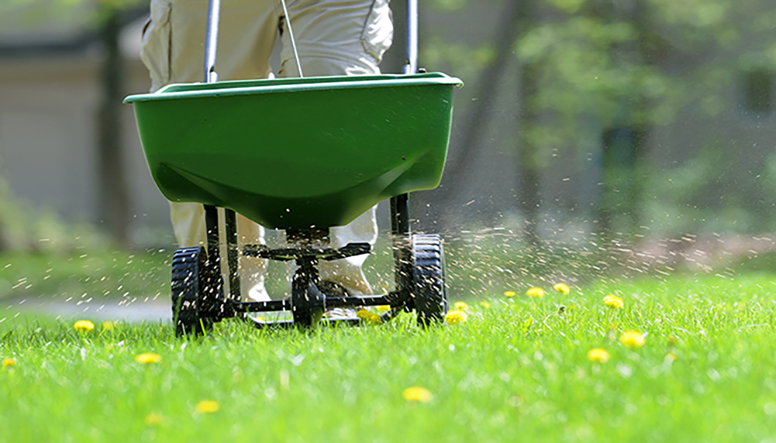Imagine stepping outside your door onto a lush, green carpet of grass that feels like heaven under your feet. That dream lawn is not just for magazines or your neighbor down the street; it can be yours, too.
The secret? Effective fertilization. Whether you’re battling brown patches or just want to enhance the vibrant color of your grass, knowing how to fertilize your lawn properly is essential. This guide is crafted just for you, to unravel the mysteries of lawn fertilization without the jargon.
By the time you finish reading, you’ll have the confidence and know-how to transform your lawn into the envy of the neighborhood. Dive in to discover the simple steps to a lawn that makes you proud every time you look out the window.

Credit: www.loveyourlandscape.org
Quick Navigation
Choosing The Right Fertilizer
Choosing the right fertilizer is crucial for a healthy lawn. Not all fertilizers are the same. Knowing the differences helps you make the best choice.
Types Of Fertilizers
Fertilizers come in different forms. Granular and liquid are the most common types. Granular fertilizers are easy to spread. They release nutrients slowly, feeding the lawn over time. Liquid fertilizers work faster. They are mixed with water and applied directly. This gives quick results but needs more frequent applications.
Organic Vs Synthetic Options
Organic fertilizers are made from natural materials. They improve soil health and encourage beneficial microbes. Examples include compost and manure. Synthetic fertilizers are man-made. They deliver nutrients quickly and are easy to apply. They might not improve the soil long-term. Both types have their benefits. Choose based on your lawn’s needs and your environmental preferences.
Reading Fertilizer Labels
Fertilizer labels provide vital information. Look for the N-P-K ratio. This shows the percentage of nitrogen, phosphorus, and potassium. Nitrogen promotes green growth. Phosphorus supports root development. Potassium helps overall health and disease resistance. Check for application instructions. Follow them carefully for the best results.

Credit: www.canr.msu.edu
Timing Your Fertilization
Applying fertilizer at the right time ensures healthy grass growth. Early spring provides nutrients for new shoots. Late fall strengthens roots for winter.
Timing your fertilization is crucial for a healthy lawn. Fertilizer can transform your grass from dull to vibrant, but applying it at the wrong time can lead to disappointment. Understanding when to fertilize ensures your lawn gets the nutrients it needs to thrive.Seasonal Considerations
Different seasons require different approaches. In spring, your lawn wakes up from dormancy and needs a nutrient boost. This is when you should apply a nitrogen-rich fertilizer to promote growth.Summer requires a different strategy. High temperatures can stress your lawn, so a slow-release fertilizer is ideal. It provides nutrients over time, reducing the risk of burning your grass.Fall is all about strengthening the roots. Using a fertilizer high in potassium can prepare your lawn for winter. It helps with root development and stress tolerance, setting the stage for a healthy spring.Frequency Of Application
How often do you fertilize your lawn? The answer depends on your grass type and local climate. Typically, fertilizing two to four times a year is sufficient for most lawns.Cool-season grasses, like fescue or bluegrass, benefit from a fall and spring application. Warm-season grasses, such as Bermuda or St. Augustine, should be fertilized in late spring and summer.But remember, over-fertilizing can harm your lawn. Watch for signs of nutrient deficiency, like yellowing leaves, to adjust your schedule accordingly.Have you ever noticed your lawn turning a vivid green after fertilizing? That’s the magic of timing. By aligning your fertilization with your lawn’s growth cycles, you achieve lush, green results. So, when will you schedule your next fertilization?Preparing The Lawn
Proper lawn fertilization ensures lush, green grass. Choose the right fertilizer for your soil type. Apply evenly, following package instructions for best results.
Preparing your lawn for fertilization is a crucial step that sets the foundation for a lush and healthy green space. Just like you wouldn’t paint a wall without cleaning it first, your lawn needs some preliminary care to absorb nutrients effectively. This process involves understanding your soil’s needs and ensuring your grass is in optimal condition for feeding.Soil Testing Basics
Before you rush to apply any fertilizer, it’s essential to know what your soil truly needs. A soil test provides a snapshot of the nutrient levels and pH balance of your lawn. You can easily purchase a soil testing kit from a garden store or send a sample to a local extension service.Imagine discovering that your soil lacks nitrogen but has plenty of phosphorus. With this knowledge, you can select a fertilizer that provides the missing nutrients, ensuring your lawn gets exactly what it needs. Without testing, you might end up adding nutrients that are already abundant, leading to wastage and potential harm to your lawn.Mowing And Watering Before Fertilization
Preparing your lawn doesn’t stop at soil testing. Mowing your lawn before applying fertilizer helps the nutrients reach the soil surface more effectively. Trim your grass to a moderate height—not too short, as this can stress the grass.Watering is another critical step. A well-hydrated lawn can absorb fertilizer more efficiently. However, avoid watering right before fertilizing, as this can cause the nutrients to wash away. Instead, water a day or two beforehand to ensure the soil is moist but not soggy.Have you ever tried fertilizing a dry lawn? It’s like trying to mix paint without water—nothing sticks, and the results are patchy at best. By focusing on these preparatory steps, you ensure your lawn is ready to make the most of every nutrient you provide.Taking the time to prepare your lawn properly can make all the difference in achieving that vibrant green look. Are you ready to give your lawn the care it deserves?Application Techniques
When it comes to fertilizing your lawn, application techniques can make all the difference between a lush green carpet and a patchy yard. The method you choose affects how evenly your lawn receives nutrients. Whether you’re using a broadcast spreader for uniform coverage or spot treating problem areas, these techniques can help you maintain a healthy lawn. Let’s dive into these approaches to ensure you give your grass the nourishment it needs.
Using A Broadcast Spreader
A broadcast spreader is your best friend for covering large areas quickly and evenly. Imagine pushing a lightweight cart that sprinkles fertilizer granules as you walk. That’s essentially what a broadcast spreader does. You load the fertilizer, adjust the settings, and stroll across your lawn.
It’s crucial to ensure the spreader settings align with the fertilizer instructions. Too much fertilizer can burn your grass, while too little won’t deliver the necessary nutrients. Walk at a steady pace to maintain even distribution. If you rush, your lawn might end up with streaks of over-fertilization.
Have you ever thought about the direction you walk? Overlapping paths slightly can help avoid missed spots. This technique mimics the way farmers sow seeds in fields, ensuring no area is left unfertilized. Taking your time to overlap paths might be the trick your lawn needs for that perfect green hue.
Spot Treating Problem Areas
Not all lawn issues need a full spread of fertilizer. Some areas might demand extra attention due to weed invasion or poor soil. Spot treating is the targeted approach to address these specific problem areas without overdoing it.
Identify spots that look unhealthy or undernourished. These can be patches where the grass is yellowing or sparse. Using a hand-held spreader or even manually applying fertilizer can work wonders. This approach allows you to give extra care where it’s most needed.
Why not keep a journal of these spots? Track the changes after spot treating. You might discover patterns in your lawn’s health that inform future care decisions. Who knew a simple notebook could become your lawn’s best ally in staying green and vibrant?
Which technique will you try on your lawn? Whether you choose to blanket your yard or target specific areas, applying fertilizer thoughtfully can transform your lawn. Remember, the key is consistency and attention to detail. Your lawn will thank you for it!
Post-fertilization Care
Fertilizing your lawn is just the beginning. Post-fertilization care is crucial for maintaining a lush, green lawn. Proper care ensures that nutrients are absorbed efficiently. This involves watering and monitoring the lawn’s health.
Watering After Application
Watering is essential after fertilizing. It helps the fertilizer penetrate the soil. Use a gentle spray to avoid washing away nutrients. Water deeply but avoid puddling. This ensures even distribution of nutrients. Early morning is the best time to water. It minimizes evaporation and fungal growth. Consistent watering aids in root development.
Monitoring Lawn Health
Keep an eye on your lawn’s color and growth. Look for signs of stress or discoloration. Brown patches may indicate over-fertilization. Adjust the care routine if needed. Regular mowing helps maintain lawn health. Set mower blades high to avoid stress. Check for weeds and pests regularly. Address issues promptly for a healthy lawn.
Avoiding Common Mistakes
Fertilizing your lawn is crucial for its health and growth. Mistakes can harm your grass and waste your efforts. Understanding these common errors can save you time and money. Proper fertilization ensures a lush and vibrant lawn. Let’s explore some common mistakes and how to avoid them.
Over-fertilization Risks
Too much fertilizer can damage your lawn. It leads to nutrient imbalance and weakens grass roots. Excess nitrogen can cause rapid growth, making mowing harder. Over-fertilizing can also pollute nearby water sources. Follow recommended guidelines to protect your lawn and environment.
Understanding Burn Spots
Burn spots appear when fertilizer concentration is too high. They are brown patches on your lawn. Burn spots can occur from uneven spreading of fertilizer. Watering your lawn after fertilizing reduces burn risk. Use a spreader for even application and avoid dumping fertilizer in one spot.
Environmental Considerations
Fertilizing a lawn requires careful consideration of environmental factors. Responsible fertilizing practices can protect the environment and promote healthy lawns. It’s essential to understand how fertilizers impact the ecosystem. This knowledge helps in making eco-friendly choices.
Eco-friendly Fertilizing Tips
Choose organic fertilizers for a natural approach. They break down slowly, reducing runoff. Organic options often contain nutrients from plant and animal sources. Use slow-release fertilizers to minimize environmental impact. They provide nutrients gradually over time. Avoid fertilizing before heavy rain. This can prevent runoff into waterways. Test your soil before applying fertilizer. This ensures you only use what your lawn needs.
Impact On Local Ecosystems
Excess fertilizer can harm local water bodies. Nutrient runoff leads to algal blooms, affecting water quality. Algal blooms can deplete oxygen in water, harming aquatic life. Fertilizers can also affect soil health. Over-fertilizing can lead to nutrient imbalances. This impacts not only the lawn but surrounding plants.

Credit: aalawns.com
Conclusion
Fertilizing your lawn doesn’t have to be complicated. Start with understanding your grass type. Test your soil to know what nutrients it needs. Use the right fertilizer for your lawn. Follow instructions carefully to avoid over-fertilizing. Water the lawn after fertilizing for better absorption.
Regular maintenance keeps your lawn healthy and green. A well-fertilized lawn boosts your home’s curb appeal. Enjoy the beauty of your lush and vibrant yard. Remember, a little effort goes a long way. Happy gardening!